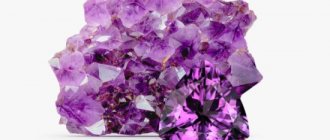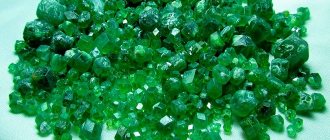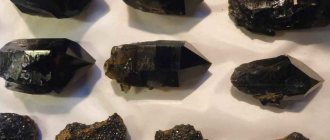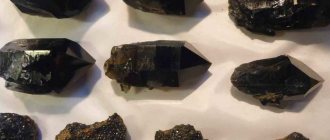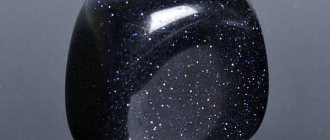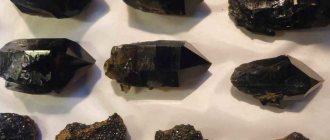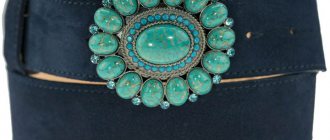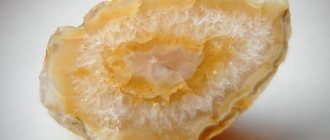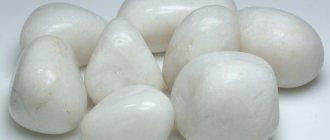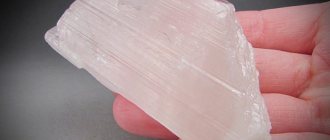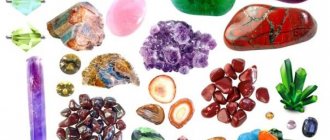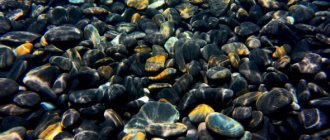Precious blue stones
Precious stones are rarely found in nature. Used to make jewelry. In our country, 7 minerals are classified as precious stones. Only 2 of them can have a cornflower blue hue:
- Blue diamond is a very rare stone, the cost of which starts from 10,000,000 rubles per carat. The natural mineral is mined only in South Africa and no more than 1 copy per year.
- Sapphire is a cornflower-blue gem, a type of corundum. The price of natural stone starts from 20,000 rubles per carat. Sapphire is able to protect its owner from envy, deception, improve financial condition, and bring good luck.
Physicochemical characteristics
Lapis lazuli stone is considered a semi-precious mineral of the first order. It has a relatively low price and is mined in many countries. The mineral is not considered a gemstone and does not belong to the category of gems. Most often it is found in the form of large inclusions and veins of other rocks - mainly in granite. Sometimes there are nuggets in the form of crystals.
The second name of the stone is “lapis lazuli”. It was this name that was used in Europe and Russia until the eighteenth century. This stone is characterized by a blue or blue tint. It is completely opaque. As a rule, minerals have golden elements - veins or inclusions. Their presence is associated with the presence of pyrite in the composition.
In addition to the sparkles of pyrite that give the mineral its glow, its surface is often covered with spots of feldspars. Rarer stones are green or lilac in color.
Note! Natural lapis lazuli is similar in appearance to azurite, but the minerals have different formulas. The second stone has lower density and more obvious color transitions, but does not contain golden elements.
The mineral is a complex compound. It includes sulfur, silicon, aluminum, sodium and oxygen. The blue tint of the stone is due to the presence of sulfur in the composition. The intensity of the color depends on its volume. The volume of sulfur in lapis lazuli is 0.7%. This substance partially replaces silicon.
Calcium may also be detected in the composition. It also contains individual elements of feldspars, as well as pyrite. The mineral belongs to the subclass of framework aluminosilicates.
This mineral is characterized by a hardness parameter of 5.5. It can be damaged with a carbon or alloy steel knife. The stone does not scratch the glass.
Lapis lazuli crystals are very rare. In its usual form, stone is found in nature in the form of veins in marble or massive blocks. The properties of lapis lazuli are related to the ease of processing. In this case, the stone can be easily damaged.
The physical and chemical properties of the stone include the following:
- formula – Na[(AlSiO4)SO4];
- glass shine;
- different variations of blue color;
- translucent structure;
- hardness – 5.5;
- implicit cleavage;
- conchoidal, granular fracture;
- density – 2.38-2.42 g/cm3.
Semi-precious blue minerals
Semi-precious stones are minerals from which jewelry is also made, but they are much more common in nature and are not rare.
Among the semiprecious stones of cornflower blue color, the following specimens can be distinguished:
- Blue chalcedony (sapphirine) is a mineral of light blue, azure shades, which has a matte or translucent structure. It is able to endow its owner with calmness, patience, give longevity, and find love. The cost of 1 carat chalcedony starts from 6,000 rubles.
- Turquoise is a gem that can change its shade depending on age. The young stone has a light, almost white color, then becomes sky blue (the most valuable specimen), and then greenish. This is an opaque sample with veins and inclusions, 1 carat of which costs 1,500 rubles. Protects the owner from various types of injuries and brings good luck in trading.
- Lapis lazuli (heavenly stone) is a dark cornflower blue gem with white or purple inclusions. Lapis lazuli is a feminine stone that restores hormonal levels and helps to bear and give birth to a healthy child. Lapis lazuli size of 1 carat costs 300 rubles.
- Aventurine is an opaque cornflower blue mineral with golden veins and sparkles. It is the strongest protective talisman, enhances the positive qualities of the owner, gives good mood and clarity of mind. Aventurine of 1 carat size costs 300 rubles.
- Aquamarine is a transparent, heavenly-colored crystal that looks like a piece of ice. It is able to change its color depending on the viewing angle from light blue to bright blue. The gem has a beneficial effect on the cardiovascular system. The cost of an aquamarine weighing 1 carat is from 4,000 rubles.
- Benitoite is a rare transparent mineral from blue to dark cornflower blue with pronounced pleochroism, similar in appearance to sapphire. It helps you build a career, become famous in your field, and gain recognition. The cost for 1 carat is about 65,000 rubles.
- Kingfisher jade is a variety of sky-colored jadeite, the main deposit of which is located in Guatemala. Its cost per 1 carat is about 10,000 rubles. It is believed that jadeite brings happiness to the owner.
- Iolite is a natural imitation of sapphire, a transparent gem of a cornflower blue or violet hue. Improves family relationships, calms the nervous system, helps in the treatment of mental illnesses. Price – about 1000 rubles per carat.
- Girazole is a transparent variety of blue opal. Peruvian opal is an opaque sea green mineral. Cost – from 10,000 rubles. The gem is capable of maximizing the talents of its owner.
- Blue quartz teaches you to accept the situation and easily pass the tests that fate presents. Price – from 500 rubles.
- Tanzanite is a variety of zoisite, a representative of a dark blue, violet, purple hue. They are mined only in one place - Tanzania. Price – 27,000 rubles per 1 carat. It has strong pleochroism and pronounced alexandrite effects (changes color depending on lighting). Tanzanite influences the internal development of a person and reveals awareness.
- London Blue Topaz is a variety of topaz that looks like the evening sky, obtained by irradiating blue topaz with neutrons. Price – from 1000 rubles per carat. It is a stone of optimism, friendship, spiritual purity and joy.
- Tourmaline - has different shades, there are 2 blue varieties: cornflower blue elbaite and dark blue indigolite. A mineral of spiritual development that helps develop consciousness and creativity. Price – from 4000 rubles per carat.
- Starlite is a bright cornflower blue variety of zircon. Promotes the development of memory and observation skills. Price – from 4000 rubles per carat.
- Spinel - has different shades, including blue. Spinel protects the human soul from demons and purifies thoughts. Cost – from 50,000 rubles.
- Irnimite is a type of jasper of heterogeneous texture of a cornflower blue hue with colored veins and spots randomly located on the surface of the gem. Price – from 6000 rubles per carat.
To view the photo gallery:
Blue chalcedony
Turquoise
Lapis lazuli
Aventurine
Benitoite
Kingfisher jade
Iolite
Girazole
Blue quartz
Tanzanite Starlite
Spinel
Irnimit
Color varieties
The mined mineral is not always of a heavenly hue. There are stones of blue and deep blue color. There are minerals with a greenish tint, as well as violet-lilac specimens. The color of the stone can be either uniform or complemented by blots, “eyes” or sheets of various inclusions - pyrite, gray or white spar. Lapis lazuli with veins of feldspars is considered a low-grade material.
Also read: Uvarovite - the emerald beauty of the Urals
The most valuable material is considered to be Badakhshan lapis lazuli. The national stone of Afghanistan is divided into three varieties:
- Niili. The stone is a deep blue color. It can be plain or with pyrite veins.
- Asmani. Sky blue mineral. It also comes in light blue.
- Sufsi. A nugget with a greenish tint and various inclusions.
Niili is considered the most expensive variety of Afghan lapis lazuli. The price of such a processed stone inserted into a product reaches 10 US dollars per gram. Sufsi is the cheapest subspecies.
Lapis lazuli from the Russian Baikal region is close in color palette to the Badakhshan mineral. The blue tit from the Pamirs and Chile is paler.
Decorative and ornamental blue crystals
Ornamental minerals are the least valuable stones that are used to make decorative items or jewelry.
- Onyx is an ornamental gem from which bracelets, beads, candelabra, and photo frames are made.
- Dumortierite is a light blue mineral used to produce high-quality porcelain, souvenirs, and jewelry.
- Kyanite is a cornflower blue or violet-blue gemstone, widely used in industry or for creating decorative items.
- Azyrite is a natural imitation of lapis lazuli, used in jewelry.
- Cubic zirconia, moissanite are artificial imitation of diamonds, including blue ones.
- Alpanite is a cornflower blue mineral that is used to make jewelry.
See photos of stones:
Onyx
Dumortierite
Kyanite
Azyrit
cubic zirconia
Alpanit
How to properly combine jewelry with jewelry stones
The ideal combination of jewelry can be achieved by combining sapphires and diamonds. Whatever your outfit, you will look stunning when you wear sapphire earrings and a diamond pendant.
Zircon is best worn as a pendant on a gold chain or as a stand-alone bracelet.
The dark blue lapis lazuli stone looks good in cufflinks or earrings; beads are often made from the mineral.
Aquamarine looks equally good in gold or silver frames.
Sacred Blue Stone
On the territory of Russia, on the shore of Lake Pleshcheevo in Pereslavl-3alesky, there is a sacred blue stone, which is about 2000 years old. This 12-ton gray boulder turns blue after rain (the surface is made of biotite and quartz, which change color when they absorb water).
They tried to get rid of the boulder several times. In the 18th century it was buried in the ground, but it ended up on the surface (external waters washed away the ground).
In the 19th century, it was planned to be used for the construction of the Spiritual Church and was transported across the lake on ice. The ice could not stand it, and the stone fell underground. However, after 70 years he found himself on the surface again. Over time, as a result of geological processes, the boulder began to go underground.
Since ancient times, people have turned to him to make a wish and gain health. To make your wish come true, you should bring a gift (a coin) to the stone and tie a ribbon on the tree closest to it, which is sold in souvenir shops near the boulder.
Healing and magical properties of blue stones
Cornflower blue stones have several common properties that are characteristic of both ornamental and precious representatives.
They help get rid of dissatisfaction with your own life, discover extrasensory abilities, and improve your creative abilities. They also protect against other people’s magical interference: the evil eye and damage.
They also have medicinal properties:
- help with cardiovascular diseases;
- reduce blood pressure;
- strengthen the immune system;
- have a beneficial effect on the psycho-emotional sphere;
- treat skin diseases (eczema, allergies, psoriasis).
Blue gems are suitable for air and water zodiac signs. For women with the names Nadezhda, Svetlana, Victoria, for men - Peter, Boris, the gem will bring good luck and financial well-being.
To watch a video about the properties of some stones:
Rules for wearing and care
When buying jewelry with natural minerals, you should take into account the favorable time to purchase a particular stone. For lapis lazuli, this is the week before the full moon.
Wearing the heavenly mineral constantly is not recommended . The maximum daily interaction time is 5 hours. Particular attention must be paid to energetic cleaning and recharging of the nugget. The first procedure is carried out during the last ten days of the sign of Pisces (March 16-21).
Also read: Ammonite - the source of ancient magic
The blue tit is cleaned under running river water or water from a stream. In the days of the first decade of the Aries sign, it is advisable to charge the heavenly stone with fiery energy - move the mineral three times in a clockwise direction over a burning candle.
As for the rules of care, lapis lazuli is unpretentious. The main thing is to avoid mechanical damage and keep it in a separate bag made of soft fabric. You can wash the stone with regular clean water. In case of severe contamination, the use of cleaning agents is allowed, since lapis lazuli is resistant to acids and alkalis (in addition to hydrochloric acid).
